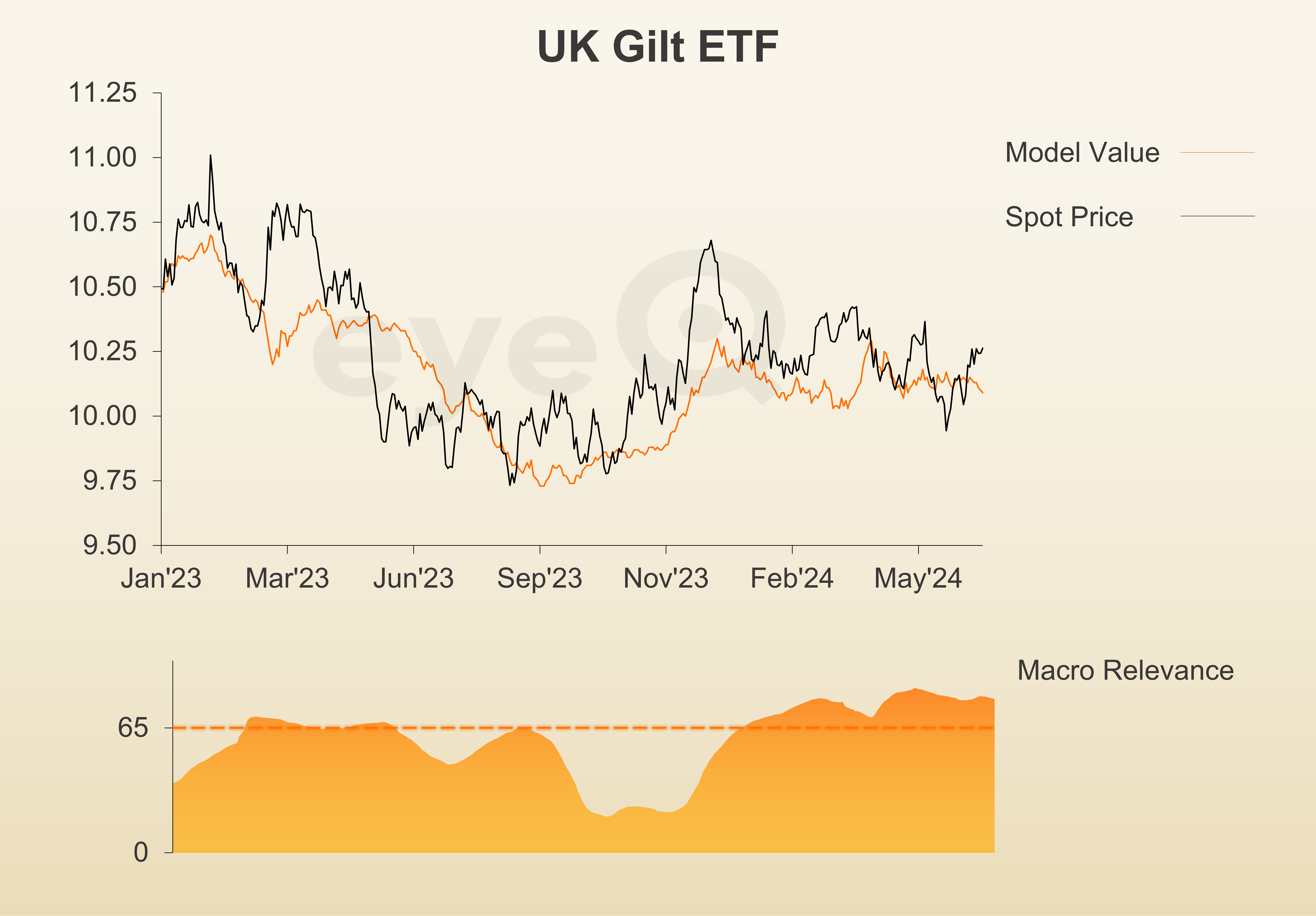eyeQ: is this still a good entry level for UK gilts?
interactive investor has teamed up with the experts at eyeQ who use artificial intelligence and their own smart machine to analyse macro conditions and generate actionable trading signals. This time it analyses the UK government bond market.
21st June 2024 11:21
by Huw Roberts from eyeQ

"Our signals are crafted through macro-valuation, trend analysis, and meticulous back-testing. This combination ensures a comprehensive evaluation of an asset's value, market conditions, and historical performance." eyeQ
UK Gilt ETF
Trading signal: long-term strategic model
Model value: £10.10
Fair Value Gap: +1.4% premium to model value
Model relevance: 80%
Data correct as at 21 June 2024. Please click glossary for explanation of terms.
The conventional wisdom is that you should own some bonds in your portfolio to act as a diversifier – which is the jargon used to say that when an economy hits the rocks and equities suffer, bonds should perform well and help provide an offset.
For some investors, exchange-traded funds (ETFs) that provide exposure to the entire gilt market is the most convenient way to get some bonds into your portfolio mix. interactive investor has several including the Vanguard Government Bond index.
Financial advisers will have a view on the optimal mix between stocks and bonds. But it is worth noting that global government bond markets have rallied hard recently. A run of slower economic data, most notably in the US, has several people dusting off their forecasts for an imminent recession.
On eyeQ, the ETFs providing exposure to US Treasuries are looking stretched. Given how much they’ve rallied in June, these do not look great entry levels to buy bonds as protection against a possible recession.
The picture for gilts is similar, if not quite as over-extended. Gilts have rallied for the same reasons as US Treasuries – slower growth, falling inflation and hopes of rate cuts from the Bank of England and Federal Reserve.
eyeQ models an iShares Core UK Gilts ETF GBP Dist (LSE:IGLT) (see chart below) that does the same thing as the Vanguard index above – it tracks the UK government bond market, aka gilts. It now sits 1.4% rich to overall macro conditions.
That’s not rich enough for our smart machine to fire a bearish signal; but it is enough to say it’s a risk chasing prices higher at this stage.
Looking to use bonds to adopt a slightly more defensive stance should equity markets wobble is the right way to be thinking. But, from a macro perspective, we’d hope to see a pullback and better entry level.

Source: eyeQ. Past performance is not a guide to future performance.
Useful terminology:
Model value
Where our smart machine calculates that any stock market index, single stock or exchange-traded fund (ETF) should be priced (the fair value) given the overall macroeconomic environment.
Model (macro) relevance
How confident we are in the model value. The higher the number the better! Above 65% means the macro environment is critical, so any valuation signals carry strong weight. Below 65%, we deem that something other than macro is driving the price.
Fair Value Gap (FVG)
The difference between our model value (fair value) and where the price currently is. A positive Fair Value Gap means the security is above the model value, which we refer to as “rich”. A negative FVG means that it's cheap. The bigger the FVG, the bigger the dislocation and therefore a better entry level for trades.
Long Term model
This model looks at share prices over the last 12 months, captures the company’s relationship with growth, inflation, currency shifts, central bank policy etc and calculates our key results - model value, model relevance, Fair Value Gap.
These third-party research articles are provided by eyeQ (Quant Insight). interactive investor does not make any representation as to the completeness, accuracy or timeliness of the information provided, nor do we accept any liability for any losses, costs, liabilities or expenses that may arise directly or indirectly from your use of, or reliance on, the information (except where we have acted negligently, fraudulently or in wilful default in relation to the production or distribution of the information).
The value of your investments may go down as well as up. You may not get back all the money that you invest.
Equity research is provided for information purposes only. Neither eyeQ (Quant Insight) nor interactive investor have considered your personal circumstances, and the information provided should not be considered a personal recommendation. If you are in any doubt as to the action you should take, please consult an authorised financial adviser.
Disclosure
We use a combination of fundamental and technical analysis in forming our view as to the valuation and prospects of an investment. Where relevant we have set out those particular matters we think are important in the above article, but further detail can be found here.
Please note that our article on this investment should not be considered to be a regular publication.
Details of all recommendations issued by ii during the previous 12-month period can be found here.
ii adheres to a strict code of conduct. Contributors may hold shares or have other interests in companies included in these portfolios, which could create a conflict of interests. Contributors intending to write about any financial instruments in which they have an interest are required to disclose such interest to ii and in the article itself. ii will at all times consider whether such interest impairs the objectivity of the recommendation.
In addition, individuals involved in the production of investment articles are subject to a personal account dealing restriction, which prevents them from placing a transaction in the specified instrument(s) for a period before and for five working days after such publication. This is to avoid personal interests conflicting with the interests of the recipients of those investment articles.